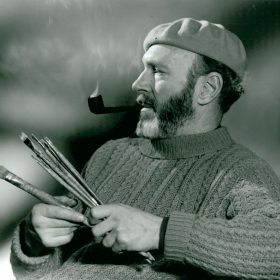Denis Peploe often sets his subject, ostensibly a still life, in a dreamscape, which might suggest landscape as a backdrop but denies conventional perspective and plays with ideas of scale. In this he is close in spirit to Marc Chagall and closer to his senior colleague at the Edinburgh College of Art, John Maxwell. In Birds and Flowers his gorgeous flowers in a vase are tilted to the left, floating, his song-birds are neither flying nor settled. An enigmatic building sits atop a plaza, or is it a tabletop? A blue moon is in partial eclipse. The lightness of these floating elements contrasts with the strongly handled oil paint, lending a rich, plastic reality to the painting.

Denis Peploe was born in 1914, the second son of the celebrated Scottish Colourist S. J. Peploe. Denis Peploe enrolled at Edinburgh College of Art at the age of seventeen where he was a contemporary of Wilhelmina Barns-Graham and Margaret Mellis. He won post-diploma scholarships to Paris and Florence and took advantage of opportunity to travel extensively in Spain, Italy and Yugoslavia. He first exhibited at The Scottish Gallery in 1947, to critical acclaim. The Glasgow Herald critic responded to the exhibition, saying he was “an artist born fully armed”; and The Bulletin critic wrote: “the general impression of the exhibition is that we have in Denis Peploe a vital and adventurous painter”. Reviewers never avoided mention of his father, and though one couldn’t confuse their work there were similarities in their approaches: each picture was a response to a particular subject, either intellectual or emotional. His son, Gallery Director, Guy Peploe explains:
‘While he was intimately exposed to the mainstream of European art he remained better defined as an artist who responded directly to his subject, en plein air or in the studio. Here the challenge was a live model, or the intellectual exercise of reinvigorating the still life subject. His work remained free of political or art-world references but was at the same time formed by the century of modernism, the times of unprecedented turmoil and change to which he belonged. His response was to cleave to the idea that art was important, even redemptive and that it could somehow describe a better, or more vital place.’
The Scottish Gallery exhibitions: 1947, 1948 1951, 1954 1984, 1988, 1990 1995 (Memorial), 2006, 2010, 2014 (Centenary)
We would be delighted to hear from you if you are considering selling any works by Denis Peploe.